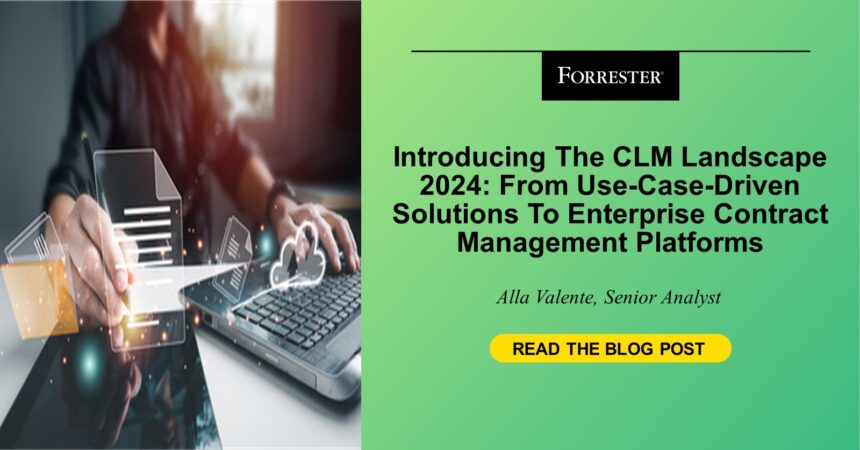As global interconnectedness exponentially increases the number of commercial and business relationships between organizations, the speed of innovation is also reshaping how they operate. In other words, for an organization to execute on its generative AI (genAI) strategy (and for the record, the absence of a genAI strategy is a genAI strategy), they’ll need to change the process and language of how they contract.
In my new report, The Contract Lifecycle Management Platforms Landscape, Q3 2024, I looked at the 27 notable vendors that a wide range of corporate stakeholders, such as procurement, legal, tech execs, and risk professionals, use to support corporate strategy, commercial activity, business operations, technology investment, and other business processes that require contractual arrangements. We define contract lifecycle management (CLM) platforms as:
Technology that automates contract digitization, creation, negotiation, execution, and governance. CLM platforms include analysis and reporting for insights into the terms, risks, obligations, and entitlements at the contract and portfolio level; metrics capture for contract(ing) optimization; and integration with adjacent technologies to ensure accuracy, efficiency, and compliance across multiple types of contracts. CLM platforms support the entire contract lifecycle, including pre-signature, post-signature, contract governance, and obligations management.
Enterprise Benefit Gain Requires An Enterprise Approach To Contract Management
In the 2023 Forrester landscape report covering CLM, it was noted that the platforms had matured from acting as digital contract repositories with authoring capabilities to complete contract lifecycle management technologies. In the 20 months since then, CLM has evolved further from use case-driven solutions for buy-side and sell-side contracts toward more comprehensive support for enterprisewide contracting. This is due to the following factors:
- Contracts are the bridge between genAI strategy and execution. How your organization goes from genAI as a strategy to genAI as a reality will largely depend on the products, services, and contracts involved. In many organizations, genAI will come by way of third parties in the form of foundation models, pretrained data, open-source large language models, and new genAI capabilities of existing third parties. The CLM becomes a critical tool to align contract language, clauses, terms, and obligations that reflect guidelines and requirements of how third parties can and should use genAI to support your organization.
- New risk/reward trade-offs require a deeper dive. Contracts are legally binding and enforceable, which means failing to align your genAI strategy and updated policies with your contracts, SLAs, and terms of use/service is a risk to your organization. To avoid this, organizations turn to CLM to identify outdated language and to flag active contracts that are not aligned with current policies.
- The speed of new regulatory change demands better alignment. Regulators are working overtime to issue new requirements to keep up with business reality. With quickly approaching effective dates for new regulations such as the Digital Operational Resilience Act (DORA), the SEC’s climate-related disclosure rules, AI regulations in the EU, and state-level AI requirements in the US, organizations must ensure their own compliance as well as assure the compliance of counterparties. As these regulations cover many risk domains and span many areas of the business, organizations require a CLM that can provide an enterprisewide perspective.
- The litigation juggernaut proves that compliance is the floor, not the ceiling. Like it or not, corporate class-action lawsuits are on the rise and compounded by the velocity and complexity of claims. As the speed and scale of AI adoption accelerates and as updates to existing regulation lag, the courtroom becomes the arena for AI concerns. To avoid that fate, the CLM has become a crucial tool for enterprise risk, governance, and accountability.
Read the full report for more details on CLM market dynamics, notable vendors, and top use cases. Also, schedule an inquiry or guidance session with me for further insights or to discuss your CLM program.







